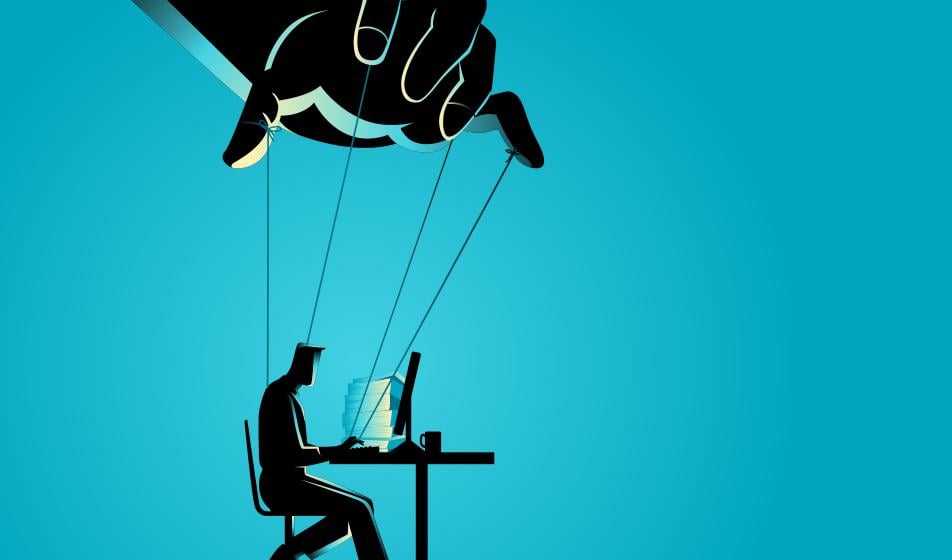What is a micromanager, and why do people micromanage? This sinister way of managing employees can infiltrate any workplace or organisational culture.
Micromanagement is one of the worst, most damaging and morale-sapping ways of managing people. It can seriously affect productivity, employee retention and ultimately, damage people’s health.
A manager's job is to provide guidance and support. Their role is to facilitate a healthy environment where employees can perform at their best - reaching their potential by having true autonomy in their roles and building their confidence. Unfortunately micromanagers achieve exactly the opposite.
In this blog, we cover:
What is micromanagement?
Micromanagement is where managers feel the need to control aspects of their employee's work & decision-making to an extreme degree - more than is necessary or healthy for a usual working relationship.
Many people have experienced micromanagement at some point in their careers. Being micromanaged can reduce an employee's confidence, extinguish autonomy and severely impact creativity - and believe it or not, that's the best-case scenario.
At worst, being micromanaged can lead to employees seeking work elsewhere, or even lead to long-term anxiety, stress & depression.
Are you being micromanaged?
If you’re reading this and in a dark place as a result of being micromanaged, please seek help as soon as you can. When you’re being micromanaged - and we'll cover the signs and symptoms shortly - one of the worst things is the drain in self-confidence. It can be incredibly difficult to put your hand up and ask for help.
But help is available and if you feel you're in this situation, it's best to start a confidential discussion with your HR team about what you're experiencing.
Trying to manage a micromanager?
Do you employ people to manage your wider teams? If the answer's yes, the rest of this
piece is for you.Micromanagers, through surface-level diligence, commitment and attention to detail may seem like model managers, but often use this to hide in plain sight and disguise working practices which – if you had visibility that they were going on – would probably horrify you.
Keep reading to discover the key symptoms of micromanagement and what you can do as a leader can do to alleviate the situation.
Why do people micromanage?
According to the Harvard Business Review, the two main reasons managers micromanage are:
-
They want to feel more connected with lower-level workers
-
They feel more comfortable doing their old job, rather than overseeing employees who now do that job
Leadership expert and best-selling author, Mark Murphy, adds a third dimension: fear. He argues that many micromanagers are terrified that their team members will do something to tarnish their hard-earned reputation, so they control excessively.
Where a micromanager felt secure in a high-performing but non-supervisory role where the quality of their work resulted in a promotion, they fear their abilities as a manager will be poorly perceived if their team members fail to measure up or make mistakes – even small ones.
The role of fear in micromanagement
The fear that drives certain types of micromanagement could also be based in a lack of trust - not trusting employees to be able to carry out tasks as required, or to the perfectionist-level standards of the micromanager. This can often lead to managers becoming overly involved, because the foundation of trust isn't there with their team. If this is the case, it's a good idea to go back to basics and try and build some trust within the team and their manager (to discourage this level of control).
We need to remind ourselves that the role of a manager is to be the team leader, the decision maker, and the coach - not to oversee every step taken by an employee.
Henry Stewart, business author and CEO of Happy has noted that in his eyes, the number one frustration employees experience is micro-management. He suggests that managers take steps to “make clear the guidelines and what you want people to achieve. And then give people the freedom to work out how to achieve that”.
And Stewart’s comments are in line with our own research. Our Culture Economy Report revealed that 21% regard micromanagement as a reason for distrust.

7 signs of micromanagement
So, let's get stuck in to the 7 ways you can identify a micromanager - then we'll provide some tips on how to deal with one.
1. Not seeing the wood for the trees
Micromanagers have a tendency to become bogged down in the minutiae of individual project strands, losing the ability to see the bigger picture.
2. Every task needs approval
For many micromanagers, the idea of giving their team members control is unthinkable. They often believe that they are the only one capable of effective decision-making.
People find themselves having to request approval about everything, rapidly diminishing self-confidence.
3. An obsession with constant updates
This can result in people spending more time producing detailed updates than focusing on what they are employed to do. With people feeling the constant need to justify themselves comes the feeling that they are not trusted to do their jobs.
4. Difficulty delegating
This causes two big problems. Firstly, a micromanager's team members wonder whether they are actually allowed to do to the work for which they were originally employed to do. This can lead to a steep decline in confidence. In turn, the micromanager becomes so overloaded with another person’s work that they fail to do their own.
5. They need to be copied into every email
The need to have visibility of every strand of communication at all times. This indicates a fear of being left out of the loop and obsession that people are discussing details and making decisions outside of their control.
6. They over-complicate instructions
An obsession with even minor details means that even straight-forward projects can quickly become ridiculously over-complicated. Instructions are so detailed and convoluted that they end up becoming incomprehensible. This can often be to retain a feeling of control, so employees are left confused and overly-reliant on the micromanager for even small decisions. This also knocks employees' confidence, which is another sinister by-product of micromanagement.
7. The belief that no one else is capable
Micromanagers often believe that they are in a management position over lesser talented people because only they can be trusted to work as effectively. As we mentioned earlier, this is often why they get involved in everything (and make sure that their team run every single decision past them for approval before moving forward).
How to manage a micromanager
Once a micromanager has been identified, it’s time to take immediate steps to deal with them in order to mitigate the damage they're doing to people, their productivity & confidence - and ultimately the company itself.
-
Try to understand
Thinking about the reasons for why the micromanagement might be happening is always useful - as mentioned earlier in this blog, is it that they're uncomfortable in a leadership role, or insecure and anxious that their team will reflect badly on them? Trying to view the situation from another perspective can help.
-
Have an honest conversation
Speaking as honestly (and professionally) as you can about how you're feeling is always a good start - start gently, by highlighting certain words or actions that make you feel demoralised or not trusted. (Starting off with "I feel micromanaged" is highly likely to produce a defensive, knee-jerk reaction and be unproductive, so tread carefully.)
-
Try and get ahead
For example, if you know your manager asks for constant updates, try and update them on important topics before they have a chance to ask. This will help to build trust, and show that you're a reliable employee who's capable of fulfilling tasks.
It's all about finding balance, of course, and no one has time to be updating their manager with every single task they're completing - so why not try and agree a communication plan that you're both happy with?
-
Escalating the issue
If these steps don't change the level of micromanagement you're feeling, it's probably time to speak to HR about how you're feeling and the impact on your wellbeing & work.
Employee wellbeing & support
It’s not the place of this article to talk about the HR policies & procedures that businesses need to follow in order to deal with micromanagers, especially in extreme and ultra-sensitive situations where further action may be required. This is where an HR professional would come in - and we'd advise you to start there within your own organisation by speaking to your HR team (or our network of professional HR Partners can help).
Micromanagers can become difficult to manage and resent what they see as an intrusion even if, ironically, it’s senior managers that they're looking to impress. Managing micromanagers takes tact and careful thought.
It’s very possible that guidance from someone else within the business could help turn a micromanager around and set them on a new path where they focus on becoming a positive rather than a toxic, controlling influence.
It's important to prioritise employee wellbeing, especially in situations that involve micromanagers. Our People First Culture Series: Wellbeing contains research around the wellbeing support employees actually want.
The importance of workplace culture
The culture of a business permeates everything it does and stands for. It’s the way people treat each other and how they live the company values. It’s the feel of the work environment and it underpins how things get done.
Business leaders who focus on creating open, positive workplace cultures where people feel supported and appreciated, with their achievements recognised by their peers and managers create an environment where it should be impossible for micromanagers to thrive.
It’s when openness becomes diluted and business leaders lose sight of how their managers are treating people that the rot sets in. This can all too easily create the toxic culture in which micromanagers thrive, and at the expense of the people they are supposed to be guiding and supporting.
Support managers & save time with Breathe
More businesses than ever before are using software to automate time-consuming manual tasks. These tasks can otherwise take over and prevent managers from spending time on helping their people grow and develop. This applies to businesses of every size and every department. HR management systems like Breathe are now an essential part of the tech mix as they reduce admin, improving productivity and efficiency as a result.
This means that HR managers and their teams can focus on personal development initiatives that bring out the best of people. This also means that they will have more time to help micromanagers re-think their ways and work more fairly, ethically & effectively.
Why not try Breathe and get started today? Your free 14-day trial is waiting for you.

Author: Aimée Brougham-Chandler
An IDM-certified Digital Copywriter as of February 2023, Aimée is Breathe's Content Assistant. With a passion for guiding readers to solutions for their HR woes, she enjoys delving into & demystifying all things HR: From employee performance to health and wellbeing, leave to company culture & much more.






